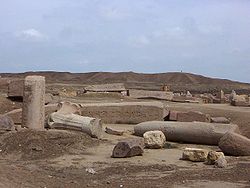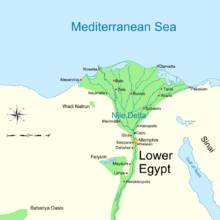
Back Tanis Afrikaans ጣኔዎስ Amharic صان الحجر القبلية Arabic تانيس ARZ Танис Bulgarian Tanis Catalan Tanis (arkiyolohiyang dapit) CEB Džanet Czech Tanis German Τάνις Greek
Tanis
ϫⲁⲛⲓ ϫⲁⲛⲏ ϫⲁⲁⲛⲉ San al-Hagar صان الحجر | |
|---|---|
 The ruins of Tanis today | |
| Coordinates: 30°58′37″N 31°52′48″E / 30.97694°N 31.88000°E | |
| Country | |
| Governorate | Sharqia |

Tanis (Ancient Greek: Τάνις or Τανέως /ˈteɪnɪs/ TAY-niss[1][2][3]) or San al-Hagar (Arabic: صان الحجر, romanized: Ṣān al-Ḥaǧar; Ancient Egyptian: ḏꜥn.t [ˈcʼuʕnat];[4] Akkadian: URUṣa-aʾ-nu;[5] Coptic: ϫⲁⲛⲓ or ϫⲁⲁⲛⲉ or ϫⲁⲛⲏ;[6][7] Hebrew: צֹועַן Ṣōꜥan, Zoan) is the Greek name for ancient Egyptian ḏꜥn.t, an important archaeological site in the northeastern Nile Delta of Egypt, and the location of a city of the same name. It is located on the Tanitic branch of the Nile, which has long since silted up.
The first study of Tanis dates to 1798 during Napoleon Bonaparte's expedition to Egypt. Engineer Pierre Jacotin drew up a map of the site in the Description de l'Égypte. It was first excavated in 1825 by Jean-Jacques Rifaud, who discovered the two pink granite sphinxes now in the Musée du Louvre, and then by François Auguste Ferdinand Mariette between 1860 and 1864, and subsequently by William Matthew Flinders Petrie from 1883 to 1886.[clarification needed] The work was taken over by Pierre Montet from 1929 to 1956, who discovered the royal necropolis dating to the Third Intermediate Period in 1939. The Mission française des fouilles de Tanis (MFFT) has been studying the site since 1965 under the direction of Jean Yoyotte and Philippe Brissaud, and François Leclère since 2013.
Today, the main parts of the temple dedicated to Amun-Ra can still be distinguished by the presence of large obelisks that marked the various pylons as in other Egyptian temples. Now fallen to the ground and lying in a single direction, they may have been knocked down by a violent earthquake during the Byzantine era. They form one of the most notable aspects of the Tanis site. Archaeologists have counted more than twenty. This accumulation of remnants from different epochs contributed to the confusion of the first archaeologists who saw in Tanis the biblical city of Zoan in which the Hebrews would have suffered pharaonic slavery. Pierre Montet, in inaugurating his great excavation campaigns in the 1930s, began from the same premise. He was hoping to discover traces that would confirm the accounts of the Old Testament. His own excavations gradually overturned this hypothesis, even if he was defending this biblical connection until the end of his life. It was not until the discovery of Qantir/Pi-Ramesses and the resumption of excavations under Jean Yoyotte that the place of Tanis was finally restored in the long chronology of the sites of the delta.
- ^ "Tanis". The American Heritage Dictionary of the English Language (5th ed.). HarperCollins. Retrieved 21 September 2019.
- ^ "Tanis". Collins English Dictionary. HarperCollins. Retrieved 21 September 2019.
- ^ "Tanis". Merriam-Webster.com Dictionary. Retrieved 21 September 2019.
- ^ Loprieno, Antonio (1995). Ancient Egyptian: A linguistic introduction. pp. 39, 245.
- ^ "Oracc RINAP Ashurbanipal 011".
- ^ Cite error: The named reference
gauthier110was invoked but never defined (see the help page). - ^ Vycichl, W. (1983). Dictionnaire Étymologique de la Langue Copte, p. 328.
